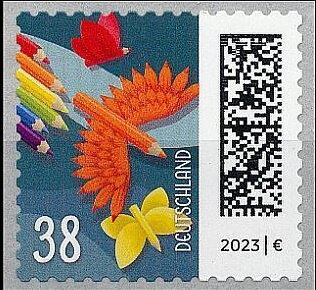Stamp: Pencils as Birds and Butterflies (Germany, Federal Republic 2023)
Pencils as Birds and Butterflies (Germany, Federal Republic 2023)
05 January (Germany, Federal Republic ) within release World of the Letter Definitives (2021-) goes into circulation Stamp Pencils as Birds and Butterflies face value 38 Euro cent
| Stamp Pencils as Birds and Butterflies in catalogues | |
|---|---|
| Michel: | Mi: DE 3742R |
Stamp is square format.
On the back of the carrier foil there is a counting number for every 5th stamp.Also in the issue World of the Letter Definitives (2021-):
- Stamp - Letters on Roller Coaster face value 30;
- Full Pane - Letters on Roller Coaster face value 10*30;
- Stamp - Letters on Roller Coaster face value 30;
- Stamp - Pencils as Birds and Butterflies face value 38;
- Full Pane - Pencils as Birds and Butterflies face value 10*38;
- Stamp - Pencils as Birds and Butterflies face value 38;
- Full Pane - Pencils Forming Small Village face value 10*33;
- Stamp - Pencils Forming Small Village face value 33;
- Stamp - Pencils Forming Small Village face value 33;
- Full Pane - Postage Stamps as Parachutes face value 10*61;
- Stamp - Postage Stamps as Parachutes face value 61;
- Stamp - Postage Stamps as Parachutes face value 61;
- Full Pane - Rainbow of Pencils in Envelope face value 10*48;
- Stamp - Rainbow of Pencils in Envelope face value 48;
- Stamp - Rainbow of Pencils in Envelope face value 48;
- Stamp - Letters on Roller Coaster face value 30;
- Stamp - Pencils as Birds and Butterflies face value 38;
- Stamp - Pencils Forming Small Village face value 33;
- Stamp - Postage Stamps as Parachutes face value 61;
- Stamp - Rainbow of Pencils in Envelope face value 48;
Stamp Pencils as Birds and Butterflies it reflects the thematic directions:
Birds (Aves), a subgroup of Reptiles, are the last living examples of Dinosaurs. They are a group of endothermic vertebrates, characterised by feathers, toothless beaked jaws, the laying of hard-shelled eggs, a high metabolic rate, a four-chambered heart, and a strong yet lightweight skeleton. Birds live worldwide and range in size from the 5 cm (2 in) bee hummingbird to the 2.75 m (9 ft) ostrich. They rank as the class of tetrapods with the most living species, at approximately ten thousand, with more than half of these being passerines, sometimes known as perching birds. Birds are the closest living relatives of crocodilians.
Butterflies are insects in the macrolepidopteran clade Rhopalocera from the order Lepidoptera, which also includes moths. Adult butterflies have large, often brightly coloured wings, and conspicuous, fluttering flight. The group comprises the large superfamily Papilionoidea, which contains at least one former group, the skippers (formerly the superfamily "Hesperioidea") and the most recent analyses suggest it also contains the moth-butterflies (formerly the superfamily "Hedyloidea"). Butterfly fossils date to the Paleocene, which was about 56 million years ago. Butterflies have the typical four-stage insect life cycle. Winged adults lay eggs on the food plant on which their larvae, known as caterpillars, will feed. The caterpillars grow, sometimes very rapidly, and when fully developed, pupate in a chrysalis. When metamorphosis is complete, the pupal skin splits, the adult insect climbs out, and after its wings have expanded and dried, it flies off. Some butterflies, especially in the tropics, have several generations in a year, while others have a single generation, and a few in cold locations may take several years to pass through their whole life cycle. Butterflies are often polymorphic, and many species make use of camouflage, mimicry and aposematism to evade their predators. Some, like the monarch and the painted lady, migrate over long distances. Many butterflies are attacked by parasites or parasitoids, including wasps, protozoans, flies, and other invertebrates, or are preyed upon by other organisms. Some species are pests because in their larval stages they can damage domestic crops or trees; other species are agents of pollination of some plants. Larvae of a few butterflies (e.g., harvesters) eat harmful insects, and a few are predators of ants, while others live as mutualists in association with ants. Culturally, butterflies are a popular motif in the visual and literary arts.


